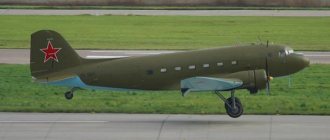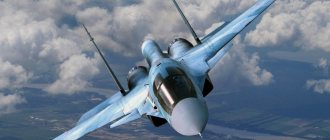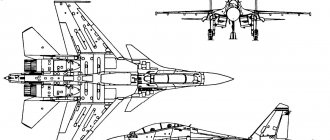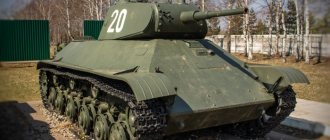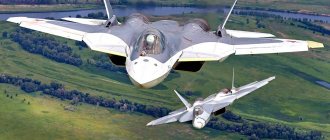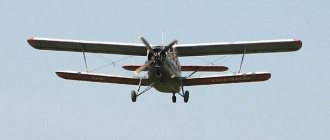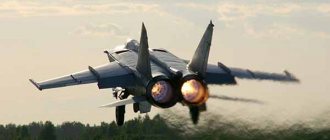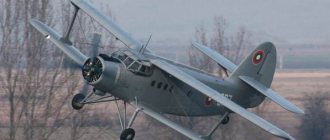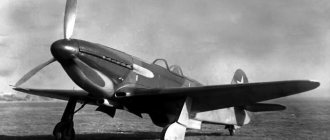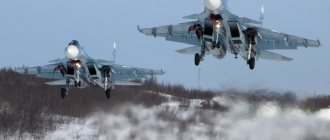The An-225 Mriya aircraft appeared at the beginning of the collapse of the Soviet Union. Created to support the Buran space program, the gigantic machine turned out to be virtually unclaimed and stood disassembled for more than 7 years. Antonov’s “Dream”, as “Mriya” is translated from Ukrainian, was saved by its outstanding load-carrying characteristics, which turned out to be in demand at the beginning of the 21st century.
The aircraft has a service life of 45 years, so the aircraft will be in the air until December 2033.
History of creation
In the 70s of the last century, the USSR and the USA competed closely in the field of space exploration. The first long-term stations appeared, to which it was necessary to deliver cargo and personnel. The disposable launch vehicles used were expensive, so the idea of creating reusable spacecraft arose. The development program for such aircraft was created first in the USA and then in the USSR.
The Soviet program included the production of spacecraft components at several enterprises. The final assembly of the reusable spacecraft, called Buran, and the Energia launch vehicle was planned at the Baikonur Cosmodrome.
The Buran flight program included landing at various airfields located on the territory of the USSR. The return delivery of the shuttle to Baikonur turned into a complex transport problem.
It was then that a proposal arose to use a large transport aircraft to deliver components and return the spacecraft to the launch pad. In the early 80s, a new idea was born to ensure takeoff from a horizontal launch pad, which could be a transport aircraft.
The plane acted as the first launch stage, and on the outer part a space shuttle was installed with a separate propulsion and fuel system.
Antonov Design Bureau proposed to create a similar aircraft based on the An-124 Ruslan components. The project of the future An-225 acquired common features by 1984. The project was led by V.I. Tolmachev.
The development and construction of the machine lasted three years. The first An-225 aircraft was built on the last autumn day of 1988. The tests proceeded at a rapid pace - after several cycles of running and taxiing tests, the plane took off. This happened in the second half of December. At the beginning of February next year, the aircraft was presented to the press at the Boryspil airfield, near Kiev.
The An-225 appeared quite late and did not have time to take part in the transportation of components for the construction of the shuttle. In the spring of 1989, Mriya was demonstrated at the Paris Air Show. The plane flew there with the Buran installed on the outer part of the fuselage.
In total, one copy of the machine was built, which is currently in operation. The construction of the second copy was frozen due to the difficult economic situation and the beginning of the collapse of the USSR.
Features and Features
The An-225 Mriya aircraft is used to transport cargo of the following categories:
- Large items placed inside the cargo compartment. The weight of the cargo over a short flight distance should not exceed 250 tons, and the length should not exceed 43 m. When flying within a continent, the weight of the cargo is limited to 200 tons; for delivery between continents, the weight is reduced to 150 tons.
- Delivery of monocargo weighing up to 200 tons, placed on the outside of the fuselage.
- It is possible to use the An-225 aircraft as a launch platform for space systems.
The dimensions of the cargo compartment allow you to accommodate:
- 16 standard aviation containers of the UAK-10 type (weighing 10 tons each);
- 50 middle class passenger cars;
- individual loads weighing up to 200 tons (for example, casings of steam or gas turbines, stators and rotors of generators for power plants, large mining dump trucks).
The history of the largest aircraft in the world
The history of the appearance of a huge aircraft with a large payload began in connection with the need to service the Buran spacecraft. Since transporting various parts of the ship to its launch site was extremely problematic, this is how this problem was solved. Due to the fact that the new transport aircraft was supposed to deliver the first stage of the spacecraft to the launch pad, its payload capacity had to be no less than 250 tons.
Since the dimensions of the AN-225 cargo compartment did not correspond to the dimensions of the launch vehicle and Buran, the transport aircraft received drawings of external fastenings developed according to special schemes. Thus, the spacecraft was transported from the outside. In this regard, the standard tail of the aircraft had to be replaced with a two-fin one that could withstand powerful aerodynamic flows.
Although the AN-225 aircraft was designed specifically as a specialized equipment designed for transporting a spacecraft, its drawings had much in common with the drawings of the first successful development of the Design Bureau named after. Antonov – AN-224 “Ruslan”, therefore, in terms of its tactical and technical characteristics and purpose, the AN-225 turned out to be a fairly universal aircraft.
Often in open sources you can find information where Balabuev is named as the chief designer. This information is not correct, since, although Balabuev was the chief designer of the Antonov Design Bureau, Tolmachev led the project to create the AN-225.
Since very short deadlines were set for the development and creation of the AN-225, thousands of different designers, engineers, technologists and other specialists from all over the Soviet Union were involved in the process of creating a new aircraft. Each company took on a separate area of work to create a huge transport aircraft:
- All the main work on the design of the AN-225 was undertaken by the Antonov Design Bureau. They also produced most of the aircraft's body parts. Fuselage assembly and general aircraft assembly were also their responsibility;
- In Tashkent at the aircraft production association named after. Chkalov were engaged in the manufacture of parts of aircraft wings, using the AN-224 base for this;
- The Ulyanovsk aircraft industrial complex was entrusted with the task of producing various large-sized parts that were manufactured by milling;
- The Kiev Aircraft Production Association was supposed to produce the front part of the fuselage, horizontal and nose tails and landing gear;
- The Moscow Institute of Automation and Electromechanics was responsible for the operation of the aircraft control complex;
- Powerful D-18 engines, the technical characteristics of which made it possible to use them for such a powerful aircraft as the AN-225, were manufactured by the Zaporozhye Engine Plant;
- Specialists from the Voronezh Aviation Plant were hired specifically to paint the new aircraft.
In addition to the above enterprises, many different components and equipment for the AN-225 were manufactured at various enterprises throughout the Soviet Union, so it would be completely wrong to consider the AN-225 Mriya (and AN-224 Ruslan) Ukrainian developments.
Technical description
The Tu-225 aircraft is built on the basis of components and parts of the Ruslan transport aircraft. The fuselage of the Mriya has an increased length due to inserts. In cross-section, the fuselage consists of two intersecting circles. There are cargo and passenger decks inside. The power structure of the fuselage is assembled using welded and adhesive joints.
The outer skin is working. To increase structural rigidity, the aft loading hatch has been removed. To ensure the possibility of placing cargo on the upper part of the fuselage, a two-fin tail unit was used.
Due to the increase in the size of the aircraft, a new wing center section was used. The wing mechanization does not differ significantly from the Ruslan. The AN-225 aircraft uses six D-18T turbojet engines developed at the Progress Design Bureau. At takeoff, the engine develops a thrust of 230 kN, the total thrust of the power plant is 1380 kN.
The engines are started by a flow of air that spins the compressor impeller.
An auxiliary power unit is used to power the starting system and operate the electrical systems when parked. It consists of two TA-12 gas turbines located on the sides of the fuselage in the chassis fairings.
On the distribution box of each D-18T engine there are two hydraulic pumps and a 60 kVA generator. The generator produces alternating high-frequency current used to operate the on-board equipment of the An-225 Mriya.
The fuel supply is located in 13 caisson-type tanks. The tanks are located in the center section and wing. The maximum tank capacity is 365 tons. Aviation kerosene TS-1 or RT substitute is used as fuel. The fuel supply provides a ferry flight range of 15,000 km.
Fully refueling an An-225 aircraft is a lengthy and complex task. Refueling time depends on the airfield equipment and tankers. In some cases, refueling the aircraft took up to a day and a half.
The chassis is equipped with a bow rotating double strut, with wheels measuring 1120*450 mm.
The main supports are located on the sides of the fuselage. Each support includes seven racks equipped with two tubeless wheels measuring 1270*510 mm. To reduce the turning radius of the aircraft on the airfield, the four rear rows of struts can be rotated.
Due to the heavy weight of the aircraft, the warranty life of the tires was 90 landings. The rubber manufacturer was the Yaroslavl Tire Plant. For all tires, an air pressure of 12 atmospheres was considered normal.
At the bottom of the fuselage there is a sealed cargo compartment. The compartment has a length of 43 m, a floor width of 6.4 m, and a height of 4.4 m. Two guides equipped with roller rollers are installed on the floor. The compartment is loaded through the cargo gate located on the front of the fuselage. To load, the nose cone rises up, and the ramp extends in parallel.
To make loading easier, the fuselage tilts forward using an adjustable nose landing gear. The strut tilts forward and the fuselage rests on two supports located on either side of the nose strut. When the fairing is closed, additional supports are removed under it.
Guides with rails for moving gantry cranes are installed on the side walls of the cargo compartment. There are a total of four cranes with a lifting capacity of 5000 kg each. To tighten cargo into the compartment, there are two winches installed on the floor. The compartment provides space for storing the airfield towing carrier.
The design of the product is unique; there is no second one like it in the world.
From the front of the cargo compartment you can access the upper deck, where the control cabin and passenger compartment are located. The compartment is divided by the wing spars and center section into two sections of different sizes. There is no direct communication between sections. In the front section adjacent to the control cabin, there are rest areas for the reserve crew (6 people).
The rear part of the passenger cabin is designed to accommodate personnel accompanying the cargo, as well as for technicians servicing crane mechanisms. The cabin is equipped with 12 seats, tables for eating and working with documentation. The cabin sections are sealed from one another. The cabin of the accompanying personnel is connected to the cargo compartment by a hatch and a ladder located in the rear of the aircraft.
The crew rest cabin is adjacent to the technical compartment located closer to the center section of the An-225 aircraft. The compartment serves as a place for installing equipment and a switching unit for pipelines of air conditioning and sealing systems. The compartment contains control of the anti-icing complex. The rear wall of the compartment is the front spar of the center section.
Shafts and drive mechanisms for the slats, and air supply pipelines from the engine nacelles are installed along the wall. Along the lower edge of the wall there are 10 cylinders of the standard fire extinguishing system, filled with freon.
The cockpit is equipped with two seats installed in front.
The ship's commander and co-pilot are located in these places. Behind them there is a passage in which the workplaces of the remaining crew members are installed - the navigator, two flight engineers (one of them is senior) and the radio operator. In the passage along the sides there are instrument panels, including a board for monitoring engine operating parameters.
It is the responsibility of the crew to ensure that the cargo is correctly positioned. This is due to the need to locate the center of gravity of the An-225 aircraft within specified limits. The loading manager installs the loads in accordance with the developed scheme. The co-pilot's responsibilities include checking the location of the cargo. The final decision on takeoff is made by the crew commander.
The control of the An-225 aircraft is equipped with hydraulic boosters. If the hydraulics fail, it is not possible to manually deflect the control planes. To prevent such situations, the control system has four control channels. The pedals and steering wheel are connected to hydraulic distributors by a system of rods and cables.
To control engine operating modes, a block of throttle levers located between the front seats is used.
The levers are connected by rods to an electromechanical fuel supply regulator located on the engine. The levers of the external pairs of engines are connected to each other during takeoff and landing.
An-225 Mriya - video
The aircraft was designed and built in the USSR at the Kiev Mechanical Plant (project manager - V.I. Tolmachev) in 1984-1988. The first flight took place on December 21, 1988. Initially, two aircraft were laid down, currently one copy is in flight condition and operated by the Ukrainian company Antonov Airlines.
History of creation
The reason for the construction of the An-225 was the need to create an air transport system for the Buran reusable spacecraft project. The main purpose of the heavy transport aircraft for this project was to transport various components of the launch vehicle and spacecraft from the production and assembly site to the launch site. There was also the important task of delivering the space shuttle to the cosmodrome in the event of its landing at alternate airfields.
In addition, it was planned to use the An-225 as the first stage of the spacecraft air launch system, which required the aircraft to have a payload capacity of at least 250 tons.
Since the blocks of the Energia launch vehicle and the Buran itself had dimensions exceeding the dimensions of the cargo compartment of the An-225, external cargo was secured on the aircraft. The presence of a wake from a large cargo attached to the top of the fuselage required replacing the single-fin tail of the An-124 with a double-fin one in order to avoid its aerodynamic shading.
Thus, the An-225 was created as an aircraft designed to solve a narrow range of rather unique transport tasks, but the use of the An-124 as a basis gave it certain qualities of a universal transport aircraft.
P.V. Balabuev is often mistakenly indicated as the chief designer. Balabuev was the general designer of the entire design bureau in 1984-2005. And V.I. Tolmachev was appointed chief designer-manager of the project by a resolution of the USSR Council of Ministers.
An-225 at the Farnborough Air Show, 1990
Features and Features
The aircraft has the ability to:
— transportation of general purpose cargo (large, heavy, long) with a total weight of up to 250 tons; — intracontinental non-stop transportation of cargo weighing 180-200 tons; — intercontinental transportation of goods weighing up to 150 tons; — transportation of heavy, large-sized monocargoes weighing up to 200 tons externally on the fuselage; — the aircraft is the basis for the creation of aerospace systems (project).
The aircraft has a spacious cargo cabin, which allows you to transport various cargoes inside the fuselage, for example:
— 16 ten-ton universal aviation containers UAK-10; — 50 cars; — monocargoes weighing up to 200 tons (turbines, generators, BelAZ, Komatsu, Euclid dump trucks, etc.).
An-225 Mriya landing with the Buran spacecraft at Le Bourget
Technical description
The An-225 is a six-engine turbojet high-wing aircraft with a swept wing and two-tail tail. Equipped with six D-18T aircraft engines manufactured by Motor Sich OJSC and developed by ZMKB Progress named after. Academician A. G. Ivchenko.
Dimensions of the cargo compartment: length - 43 m, width - 6.4 m, height - 4.4 m. The cargo compartment of the aircraft is sealed, which significantly expands its transport capabilities. Above the cargo cabin on the 2nd deck is a cabin for six replacement crew members and 88 people accompanying the cargo.
The on-board loading equipment complex, as well as the design of the front cargo hatch with a ramp, ensure fast and convenient loading and unloading operations. The aircraft is capable of carrying unique cargo on the fuselage, the dimensions of which do not allow them to be placed on other ground and air vehicles. To install these cargoes on the fuselage there is a special fastening system.
The An-225 Mriya aircraft has a high degree of continuity and unification in systems, assemblies, components and parts of the airframe, power plant and equipment with the certified An-124-100 (Ruslan) aircraft. Main differences from the An-124:
— new center section; — increasing the length of the fuselage due to inserts; — replacement of the tail unit with a two-fin one; — lack of a tail cargo hatch; — increasing the number of main landing gear struts; — system for securing and pressurizing external cargo; - two additional engines.
Cooperation in the creation of the An-225 aircraft
Data source: memoirs of Anatoly Vovnyanko, one of the designers of the An-225 aircraft.
“...In 1985, the Politburo of the CPSU Central Committee decided to begin work on the construction of the An-225 aircraft, and it was necessary to begin work both at KMZ and throughout the Ministry of Aviation Industry (MAP)... ...At all factories participating in the cooperation and supplying components, very hard, intense work was going on, since the deadlines were very tight... ...Hundreds of thousands of scientists, designers, engineers, military, pilots, workers and other specialists of the former USSR directly and indirectly participated in the creation, construction, flight testing and certification ... Low bow to all of them and many thanks!”
Below are just some of the main enterprises involved in the creation of the An-225 aircraft:
Kiev Mechanical Plant (KMZ) / OKB im. O. K. Antonova Design: main design work on the aircraft. Production: most of the new components, small fuselage parts and system parts, fairings and fairings, center section nose section and others. Assembly: assembly of the fuselage in a slipway, general assembly of the aircraft. Other work: all work after assembly.
"Ulyanovsk Aviation Industrial Complex" (UAIC) Production: new large-sized milled power frames, fuselage lows and brackets, some serial components and aircraft parts.
"Tashkent Aviation Production Association named after V.P. Chkalov" (TAPOiCh) Production: new central parts of the wings with flaps and end (detachable) parts of the wings - serial consoles from the An-124.
"Kiev Aviation Production Association" (KiAPO) Production: fuselage nose, front landing gear mounts, new horizontal and vertical tails, pylons and engine cowlings, ball screw mechanisms for the front fuselage struts and others.
"Moscow Institute of Electromechanics and Automation" (MIEA) Design: new modernized A-825 flight equipment complex (A-825M aircraft control complex) Production: A-825M aircraft control complex.
"Zaporozhye Engine Plant" (Motor Plant No. 29) Production: serial engines D-18T.
"Gidromash" Design: new aircraft landing gear Production: aircraft landing gear.
"Voronezh Aviation Plant" Painting: specialized painting with polyurethane paint (specialists from Voronezh were brought to Kiev)
Exploitation
First took to the skies on December 21, 1988. Despite the fact that the aircraft was created in the USSR to transport components of the Energia launch vehicles and the Buran spacecraft, by the time the construction of the first An-225 was completed, all necessary transportation was carried out by the VM-T Atlant aircraft, and in the Buran program “The An-225 took part only by transporting the Buran to the Paris Air Show in May 1989 and making several demonstration flights at Baikonur in April 1991.
After the collapse of the USSR, the only flying copy of the aircraft stopped flying in 1994, engines and other equipment were removed from it for use in the Ruslans. However, by the 2000s, the need for it became obvious, and it was restored by Ukrainian enterprises. The airliner has also been modified to meet the standards of aircraft for civil aviation.
On May 23, 2001, type certificates for the An-225 Mriya were issued by the Aviation Register of the Interstate Aviation Committee (AR IAC) and the State Department of Aviation Transport of Ukraine (Ukraviatrans), which made it possible to begin commercial use of the aircraft as a cargo carrier.
Currently, the An-225 carries out commercial cargo transportation as part of the air transport division of the ASTC named after. O.K. Antonov - Antonov Airlines. Design work is also being carried out to use the aircraft as a flying launch complex for aerospace systems. One of the promising projects is the Russian-Ukrainian multi-purpose aerospace system (MAKS).
In the period from May 10 to May 15, 2016, Mriya flew from Ukraine to Australia, making 4 intermediate landings along the way - at Vaclav Havel Airport (Prague, Czech Republic), Turkmenbashi Airport (Turkmenbashi, Turkmenistan), Rajiv Gandhi Airport ( Hyderabad, India) and Kuala Lumpur Airport (Kuala Lumpur, Malaysia). On May 15, the plane landed at the airport in the Australian city of Perth. The flight range was over 15.5 thousand km. Its cargo was a 117-ton generator from Brush SEM. On November 14, 2016, Mriya landed at the Brazilian Viracopos/Campinas airport. The plane delivered to Santiago an electric turbine manufactured in Brazil by ABB weighing 155 tons (total cargo weight - 182 tons), which is a record for South America. On November 27, 2016, Mriya returned to Ukraine.
An-225 chassis
Records
The An-225 is the heaviest cargo aircraft ever to fly. The only aircraft larger than the An-225 in terms of wingspan is the Hughes H-4 Hercules, which belongs to the class of flying boats and flew only once in 1947. In 2022, the largest double-fuselage transport aircraft, Scaled Composites Stratolaunch Model 351, was presented in the United States, surpassing the An-225 and Hughes H-4 Hercules in wingspan (117 m), but according to preliminary data, inferior to the Mriya in maximum take-off weight and payload capacity (Stratolaunch's first flight is scheduled for 2022)
The Mriya aircraft set a number of world records for take-off weight and payload. On March 22, 1989, the An-225 made a flight with a cargo of 156.3 tons, in which one hundred and ten world aviation records were simultaneously broken. Such an achievement is a record in itself. In August 2004, a new record was set - Mriya transported two hundred and fifty tons of special equipment ordered by Zeromax GmbH from Prague to Tashkent with an intermediate landing in Samara.
In August 2009, the aircraft was included in the Guinness Book of Records for transporting the largest monocargo cargo in the history of aviation with a total weight of 187.6 tons. It was a generator weighing 174 tons, which was transported along with a special frame from Frankfurt, Germany to Yerevan for a new Armenian power plant (see Discovery Science, Special Forces “Heavy Machines” program).
"Mriya" holds the absolute record for carrying capacity - 253.8 tons.
On June 10, 2010, the longest cargo in the history of air transportation was transported - two wind turbine blades, each 42.1 meters long. In November 2016 (see above), a record weight for South America was transported - a turbogenerator in a special design with a total weight of 182 tons.
In total, this aircraft holds about two hundred and fifty world records.
Second copy of An-225
The second copy of the An-225 aircraft is approximately 70% complete. It was planned to be completed if funding was available. The center section, fuselage and wing remained from Soviet times. This machine can be completed if a customer appears.
In 2006, Kievsky General Director Oleg Shevchenko said that to complete the construction of the An-225 aircraft, an amount of approximately $90 million was needed; including testing of the aircraft, the amount would be $120 million.
On August 30, 2016, the Chinese company Aerospace Industry Corporation of China (AICC) and the Ukrainian state-owned enterprise Antonov signed an agreement of intent, which provides for the completion and modernization of the second copy of the An-225 with its subsequent transfer to China.
Exploitation
The only copy of the An-225 aircraft received the Soviet tail number USSR-82060. After the collapse of the country and the transfer of the car to Ukraine, the number changed to UR-82060. In the spring of 1994, the flight prototype of the vehicle was mothballed (along with the second unfinished model).
The plane remained in this form until the summer of 2000, after which it was decided to return it to service. Some of the equipment on the An-225 was replaced and a number of new devices were installed to ensure flight safety.
Commercial flights began at the end of 2001. The machine is used by Antonov Airlines, a subsidiary of Antonov Design Bureau. The aircraft is chartered to transport unique large and heavy cargo over various distances.
Differences between “Ruslan” and “Mriya”
Despite the fact that the An-225 was created similar to the An-124, the new model has its own design features. The carrying capacity of the Mriya, compared to the original base, has increased by one and a half times, its length has increased by 7 meters, and its wingspan has increased by 20%. Also, the new car has two more engines installed.
The giant received a new center section and two-tail tail. A set of fastenings was added to hold the cargo on the external surface of the ship. Unlike the Ruslan, the Mriya does not have a ramp at the rear of the cargo compartment. The An-225 also received 7 main landing gear struts, all of which can be produced independently. However, just like the base model, during loading and unloading it is possible to change the distance from the fuselage to the ground and the angle of inclination of the body.
Airplane “Ruslan”
Performance characteristics and records
| Takeoff length (without load), m | 2 400 |
| Takeoff length (with full load), m | 3 500 |
| Run length (without load), m | 2 400 |
| Run length (fully loaded), m | 3 300 |
| Crew, man | 6 |
| Maximum speed, km/h | 850 |
| Cruising speed, km/h | 750 |
| Ferry flight range, km | 15 400 |
| Range with cargo, km | 4 500-9 600 |
| Permissible take-off weight, kg | 600 000 |
| Wingspan, mm | 88 400 |
| Length, mm | 84 000 |
| Height, mm | 18 100 |
The An-225 Mriya aircraft holds a series of records:
- transportation of the longest load (two wind turbine impeller blades with a length of 42.1 m each);
- the weight of cargo transported in one flight is 253,800 kg;
- the weight of the transported mono cargo is 187,600 kg.
In total, the An-225 holds more than 250 world records, many of which are unlikely to be broken in the foreseeable future.
Prospects
The second copy of the An-225 aircraft was mothballed in the early 90s. The car had an almost assembled fuselage, center section box and wing. In the mid-2000s, projects for completing the aircraft's construction appeared, but no customer was found willing to pay for final assembly and testing.
In 2006, the cost of putting the aircraft into service was estimated at 120 million US dollars.
At the end of the summer of 2016, Antonov Design Bureau signed an agreement with the Chinese company AICC. According to the agreement, the Chinese received ownership of the second copy of the aircraft after completion and modernization.
A year later, unofficial information appeared that the Chinese partners had lost interest in the aircraft. The reasons were explained by the dimensions and weight of the machine, which do not allow the aircraft to be operated from most airports. According to other sources, the first Chinese version of the An-225 transport aircraft should be built in 2022.
